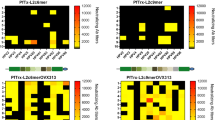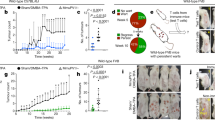Abstract
The genus beta human papillomavirus 8 (HPV8) is involved in the development of cutaneous squamous cell carcinomas (SCCs) in individuals with epidermodysplasia verruciformis. Immunosuppressed transplant recipients are prone to harbor particularly high betapapillomavirus DNA loads, which may contribute to their highly increased risk of SCC. Tumor induction in HPV8 transgenic mice correlates with increased expression of viral oncogenes E6 and E2. In an attempt to prevent skin tumor development, we evaluated an HPV8-E6-DNA vaccine, which was able to stimulate a detectable HPV8-E6-specific cell-mediated immune response in 8/15 immunized mice. When skin of HPV8 transgenic mice was grafted onto non-transgenic littermates, the grafted HPV8 transgenic tissue was not rejected and papillomas started to grow within 14 days all over the transplant of 9/9 non-vaccinated and 7/15 not successfully vaccinated mice. In contrast, no papillomas developed in 6/8 successfully vaccinated mice. In the other two of these eight mice, a large ulcerative lesion developed within the initial papilloma growth or papilloma development was highly delayed. As the vaccine completely or partially prevented papilloma development without rejecting the transplanted HPV8 positive skin, the immune system appears to attack only keratinocytes with increased levels of E6 protein, which would give rise to papillomas.





Similar content being viewed by others
References
Orth G (2006) Genetics of epidermodysplasia verruciformis: insights into host defense against papillomaviruses. Semin Immunol 18:362–374
Karagas MR, Waterboer T, Li Z, Nelson HH, Michael KM, Bavinck JN, Perry AE, Spencer SK, Daling J, Green AC, Pawlita M (2010) Genus beta human papillomaviruses and incidence of basal cell and squamous cell carcinomas of skin: population based case-control study. BMJ 341:c2986
Proby CM, Harwood CA, Neale RE, Green AC, Euvrard S, Naldi L, Tessari G, Feltkamp MC, de Koning MN, Quint WG, Waterboer T, Pawlita M, Weissenborn S, Wieland U, Pfister H, Stockfleth E, Nindl I, Abeni D, Schegget JT, Bouwes Bavinck JN, EPI-HPV-UV-CA group (2011) A case-control study of betapapillomavirus infection and cutaneous squamous cell carcinoma in organ transplant recipients. Am J Transpl 11:1498–1508
Neale RE, Weissenborn S, Abeni D, Bavinck JN, Euvrard S, Feltkamp MC, Green AC, Harwood C, de Koning M, Naldi L, Nindl I, Pawlita M, Proby C, Quint WG, Waterboer T, Wieland U, Pfister H (2013) Human papillomavirus load in eyebrow hair follicles and risk of cutaneous squamous cell carcinoma. Cancer Epidemiol Biomark Prev 22:719–727
Pfister H (2003) Chapter 8: human papillomavirus and skin cancer. J Natl Cancer Inst Monogr 31:52–56
Bouwes Bavinck JN, Neale RE, Abeni D, Euvrard S, Green AC, Harwood CA, Koning MN, Naldi L, Nindl I, Pawlita M, Pfister H, Proby CM, Quint WG, ter Schegget J, Waterboer T, Weissenborn S, Feltkamp MC, EPI-HPV-UV-CA group (2010) Multicenter study of the association between betapapillomavirus infection and cutaneous squamous cell carcinoma. Cancer Res 70:9777–9786
Weissenborn SJ, Nindl I, Purdie K, Harwood C, Proby C, Breuer J, Majewski S, Pfister H, Wieland U (2005) Human papillomavirus-DNA loads in actinic keratoses exceed those in non-melanoma skin cancers. J Invest Dermatol 125:93–97
Arron ST, Ruby JG, Dybbro E, Ganem D, Derisi JL (2011) Transcriptome sequencing demonstrates that human papillomavirus is not active in cutaneous squamous cell carcinoma. J Invest Dermatol 131:1745–1753
Schaper ID, Marcuzzi GP, Weissenborn SJ, Kasper HU, Dries V, Smyth N, Fuchs P, Pfister H (2005) Development of skin tumors in mice transgenic for early genes of human papillomavirus type 8. Cancer Res 65:1394–1400
Marcuzzi GP, Hufbauer M, Kasper HU, Weissenborn SJ, Smola S, Pfister H (2009) Spontaneous tumour development in human papillomavirus type 8 E6 transgenic mice and rapid induction by UV-light exposure and wounding. J Gen Virol 90:2855–2864
Pfefferle R, Marcuzzi GP, Akgül B, Kasper HU, Schulze F, Haase I, Wickenhauser C, Pfister H (2008) The human papillomavirus type 8 E2 protein induces skin tumors in transgenic mice. J Invest Dermatol 128:2310–2315
Akgül B, García-Escudero R, Ekechi C, Steger G, Navsaria H, Pfister H, Storey A (2011) The E2 protein of human papillomavirus type 8 increases the expression of matrix metalloproteinase-9 in human keratinocytes and organotypic skin cultures. Med Microbiol Immunol 200:127–135
Hufbauer M, Lazic D, Akgul B, Brandsma JL, Pfister H, Weissenborn SJ (2010) Enhanced human papillomavirus type 8 oncogene expression levels are crucial for skin tumorigenesis in transgenic mice. Virology 403:128–136
Frazer H (2004) Prevention of cervical cancer through papillomavirus vaccination. Nat Rev Immunol 4:46–54
Wick DA, Webb JR (2011) A novel, broad spectrum therapeutic HPV vaccine targeting the E7 proteins of HPV16, 18, 31, 45 and 52 that elicits potent E7-specific CD8T cell immunity and regression of large, established, E7-expressing TC-1 tumors. Vaccine 29:7857–7866
Kaufmann AM, Nieland JD, Jochmus I, Baur S, Friese K, Gabelsberger J, Gieseking F, Gissmann L, Glasschröder B, Grubert T, Hillemanns P, Höpfl R, Ikenberg H, Schwarz J, Karrasch M, Knoll A, Küppers V, Lechmann M, Lelle RL, Meissner H, Müller RT, Pawlita M, Petry KU, Pilch H, Walek E, Schneider A (2007) Vaccination trial with HPV16 L1E7 chimeric virus-like particles in women suffering from high grade cervical intraepithelial neoplasia (CIN 2/3). Int J Cancer 121:2794–2800
Kenter GG, Welters MJ, Valentijn AR, Lowik MJ, Berends-van der Meer DM, Vloon AP, Essahsah F, Fathers LM, Offringa R, Drijfhout JW, Wafelman AR, Oostendorp J, Fleuren GJ, van der Burg SH, Melief CJ (2009) Vaccination against HPV-16 oncoproteins for vulvar intraepithelial neoplasia. N Engl J Med 361:1838–1847
Li YL, Qiu XH, Shen C, Liu JN, Zhang J (2010) Vaccination of full-length HPV16 E6 or E7 protein inhibits the growth of HPV16 associated tumors. Oncol Rep 24:1323–1329
Hanke T, Schneider J, Gilbert SC, Hill AV, McMichael A (1998) DNA multi-CTL epitope vaccines for HIV and Plasmodium falciparum: immunogenicity in mice. Vaccine 4:426–435
Mayumi H, Nomoto K, Good RA (1988) A surgical technique for experimental free skin grafting in mice. Jpn J Surg 18:548–557
Weissenborn S, Neale RE, Waterboer T, Abeni D, Bavinck JN, Green AC, Harwood CA, Euvrard S, Feltkamp MC, de Koning MN, Naldi L, Quint WG, Tessari G, Proby CM, Wieland U, Pfister H (2012) Beta-papillomavirus DNA loads in hair follicles of immunocompetent people and organ transplant recipients. Med Microbiol Immunol 201:117–125
Euvrard S, Kanitakis J, Claudy A (2003) Skin cancers after organ transplantation. N Engl J Med 348:1681–1691
Author information
Authors and Affiliations
Corresponding author
Rights and permissions
About this article
Cite this article
Marcuzzi, G.P., Awerkiew, S., Hufbauer, M. et al. Tumor prevention in HPV8 transgenic mice by HPV8-E6 DNA vaccination. Med Microbiol Immunol 203, 155–163 (2014). https://doi.org/10.1007/s00430-014-0327-4
Received:
Accepted:
Published:
Issue Date:
DOI: https://doi.org/10.1007/s00430-014-0327-4




